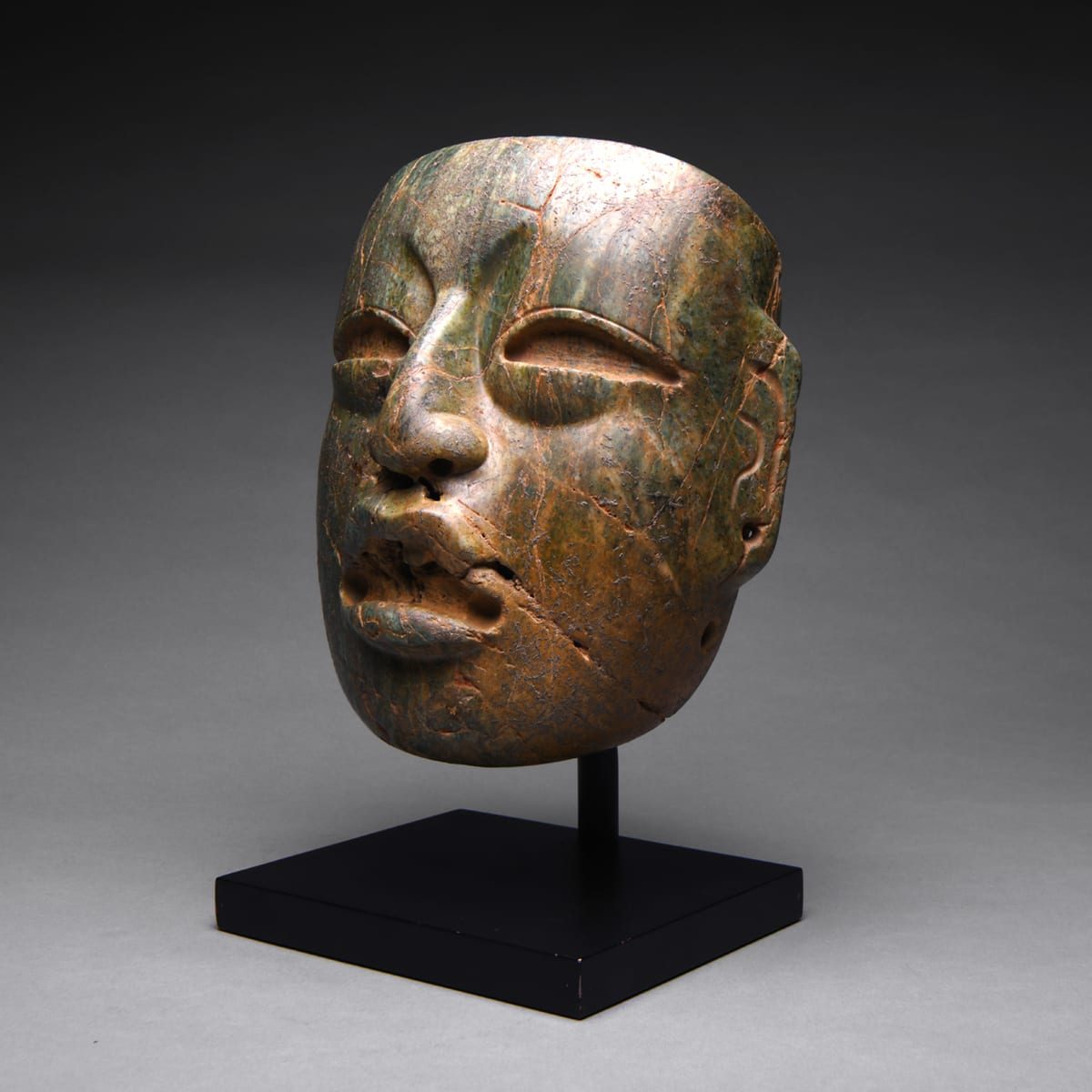Olmec Jade Mask, 900 BCE - 500 BCE
Jade
height 23.5 cm
height 9 1/4 in
height 9 1/4 in
MT.0293
Further images
The Olmecs are generally considered to be the ultimate ancestor of all subsequent Mesoamerican civilizations. Thriving between about 1200 and 400 BC, their base was the tropical lowlands of south...
The Olmecs are generally considered to be the ultimate ancestor of all subsequent Mesoamerican civilizations. Thriving between about 1200 and 400 BC, their base was the tropical lowlands of south central Mexico, an area characterized by swamps punctuated by low hill ridges and volcanoes. Here the Olmecs practiced advanced farming techniques and constructed many permanent settlements. Their influence, both cultural and political, extended far beyond their boundaries; the exotic nature of Olmec designs became synonymous with elite status in other (predominantly highland) groups, with evidence for exchange of artefacts in both directions. Other than their art (see below), they are credited with the foundations of writing systems (the loosely defined Epi-Olmec period, c. 500 BC), the first use of the zero – so instrumental in the Maya long count vigesimal calendrical system – and they also appear to have been the originators of the famous Mesoamerican ballgame so prevalent among later cultures in the region.
The art form for which the Olmecs are best known, the monumental stone heads weighing up to forty tons, are generally believed to depict kingly leaders or possibly ancestors. Other symbols abound in their stylistic repertoire, including several presumably religious symbols such as the feathered serpent and the rain spirit, which persisted in subsequent and related cultures until the middle ages. Comparatively little is known of their magico-religious world, although the clues that we have are tantalising. Technically, these include all non-secular items, of which there is a fascinating array. The best- known forms are jade and ceramic figures and celts that depict men, animals and fantastical beasts with both anthropomorphic and zoomorphic characteristics. Their size and general appearance suggests that they were domestically- or institutionally-based totems or divinities. The quality of production is astonishing, particularly if one considers the technology available, the early date of the pieces, and the dearth of earlier works upon which the Olmec sculptors could draw. Some pieces are highly stylised, while others demonstrate striking naturalism with deliberate expressionist interpretation of some facial features (notably up-turned mouths and slit eyes) that can be clearly seen in the current figure.
Depicting a stylized face with an open-mouth and narrow slit eyes, masks such as this were probably never worn. Instead, they were likely used as votive objects, serving a ritual purpose within the society, and perhaps also an apotropaic or funerary role. The open, downturned mouth is one of the characteristic motifs of the Olmec style. With enlarged upper lip and an exposed row of upper teeth (although some have broken away), this specific design evokes the so-called were-jaguar type so prevalent in Olmec art. The narrow, almond-shaped eyes are another characteristic aspect of this type. The symbolism behind the were-jaguar motif is debated with some scholars asserting that it represents a shaman in the midst of transmogrification, while other scholars doubting any relation to the jaguar at all. Other notable features of this mask include the engraved “eyelids” above the squinting eyes and the drilled hole on the top of the mask, as well as those that decorate the earlobes. The surface of this mask bears testaments to its age, with numerous fissures in the stone. This stunning mask has born witness to the passage of centuries and today confronts us from the other side.
The art form for which the Olmecs are best known, the monumental stone heads weighing up to forty tons, are generally believed to depict kingly leaders or possibly ancestors. Other symbols abound in their stylistic repertoire, including several presumably religious symbols such as the feathered serpent and the rain spirit, which persisted in subsequent and related cultures until the middle ages. Comparatively little is known of their magico-religious world, although the clues that we have are tantalising. Technically, these include all non-secular items, of which there is a fascinating array. The best- known forms are jade and ceramic figures and celts that depict men, animals and fantastical beasts with both anthropomorphic and zoomorphic characteristics. Their size and general appearance suggests that they were domestically- or institutionally-based totems or divinities. The quality of production is astonishing, particularly if one considers the technology available, the early date of the pieces, and the dearth of earlier works upon which the Olmec sculptors could draw. Some pieces are highly stylised, while others demonstrate striking naturalism with deliberate expressionist interpretation of some facial features (notably up-turned mouths and slit eyes) that can be clearly seen in the current figure.
Depicting a stylized face with an open-mouth and narrow slit eyes, masks such as this were probably never worn. Instead, they were likely used as votive objects, serving a ritual purpose within the society, and perhaps also an apotropaic or funerary role. The open, downturned mouth is one of the characteristic motifs of the Olmec style. With enlarged upper lip and an exposed row of upper teeth (although some have broken away), this specific design evokes the so-called were-jaguar type so prevalent in Olmec art. The narrow, almond-shaped eyes are another characteristic aspect of this type. The symbolism behind the were-jaguar motif is debated with some scholars asserting that it represents a shaman in the midst of transmogrification, while other scholars doubting any relation to the jaguar at all. Other notable features of this mask include the engraved “eyelids” above the squinting eyes and the drilled hole on the top of the mask, as well as those that decorate the earlobes. The surface of this mask bears testaments to its age, with numerous fissures in the stone. This stunning mask has born witness to the passage of centuries and today confronts us from the other side.









